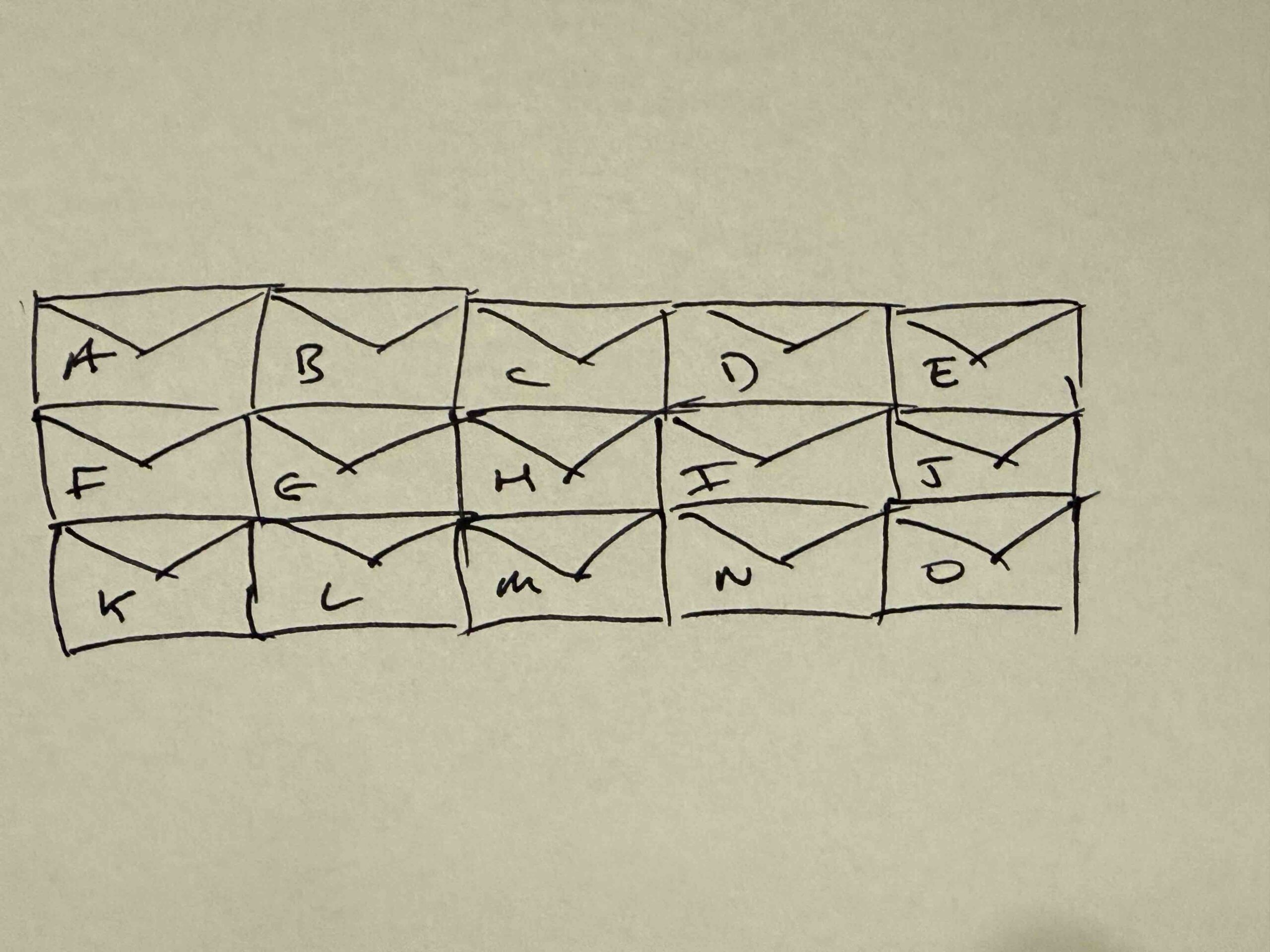Introduction
The recruitment process for positions at Smartodds has changed over the years. In the early days it used to work like this. There’d be an intensive process of interviews and tests to narrow the field of candidates down to the best two. We’d then choose between these two candidates on the basis of what we called the Letter Identification Exam (L.I.E.). This worked in the following way. We’d send each candidate a set of 15 identical envelopes, labelled alphabetically from A to O, which they were asked to lay out in a grid with 3 rows and 5 columns as per the following diagram.

Before sending the envelopes out we’d randomly choose a letter between A to O and place a “you’re hired” message in the corresponding envelope. (It would be the same message in the same lettered envelope for both candidates). The candidates were then each asked to specify an order, unknown to the other candidate, which they would follow when opening the envelopes. They could choose, for example, alphabetically from A to O, or the reverse of that, or anything else. They would then simultaneously open the envelopes one at a time, according to their respective chosen order, and whoever opened the letter containing the “you’re hired” message first would get the job. For example, following their chosen orders, if the message happened to be in envelope I, then Bill would get the job, since he would be opening that envelope on the 9th round while Ted wouldn’t have opened that envelope till the 11th round. If both candidates found the “you’re hired” message in the same round, then neither candidate was given the job.
Our reasoning for doing things this way was that by all our standard measures, the candidates had proved themselves to be equally capable. But the L.I.E. test enabled them to show something extra – an ability to overcome the random allocation of the “you’re hired” message – which would prove they had something the other candidates didn’t.
I’ve got 3 questions about this procedure that I’d like you to answer sequentially. That’s to say, think about and answer each question before moving on to the description of the next question. In a couple of weeks I’ll give the answers and some discussion about all of this. In the meantime, please feel free to contact me to discuss anything at all about this procedure.
Question 1.
In one of our earliest applications of this recruitment method we narrowed applications for an IT job down to Bill and Ted. We explained the L.I.E. procedure and asked the candidates what order they would like to open their envelopes. Bill went for row-by-row, that’s to say alphabetical from A to O. Ted went for column-wise, so A, F, K, B, G, L,… and so on. Given these choices and the fact that the “you’re hired” message had been allocated randomly among the envelopes, which of Bill and Ted was more likely to get the job?
|
|
|
|
|
|
|
|
|
|
|
|
|
|
|
|
|
Question 2.
After a while we found this procedure was taking a bit too long. So someone in HR had the idea of placing “you’re hired” messages randomly in two of the envelopes instead of one. The point being that with two messages a candidate was likely to get a “you’re hired” message quicker than if there was just one, so the process was, on average, faster. Everything else about the process remained the same – candidates still had to choose an order to open the envelopes and so on – and again a candidate was given the job as soon as they opened an envelope containing a “you’re hired” message. The location of the second “you’re hired” message was irrelevant – as soon as either candidate opened an envelope with a “you’re hired” message the procedure stopped. And again, if both candidates got that message simultaneously, neither was hired.
One time we used this method to recruit for a position in SD. Again we narrowed things down to the best two candidates, Thelma and Louise. Coincidentally, Thelma and Louise went for the same order to open the envelopes as Bill and Ted: Thelma went for row-by-row; Louise went for column-by-column. Given these choices and the random allocation of the two “you’re hired” messages, who between Thelma and Louise was more likely to get the job?
|
|
|
|
|
|
|
|
|
|
|
|
|
|
|
|
|
Question 3.
After a few attempts with this revised system we realised we weren’t saving very much time by inserting two “you’re hired” messages in random envelopes, so we went back to the original simpler procedure with just one. Unfortunately, we made a mistake while applying it on one occasion. We were recruiting for a job in Finance and narrowed things down to 2 candidates, Sid and Nancy. We asked Sid what order he would use to open the envelopes and he went for row-wise – or alphabetical – like Bill and Thelma in the previous interviews. Unfortunately, we had Sid on conference call when he made that choice and Nancy was listening in. So when we got to ask Nancy what order she’d like to open the envelopes, she already knew Sid’s choice. Nancy was really smart and virtually guaranteed she’d get the job. What did she do?
